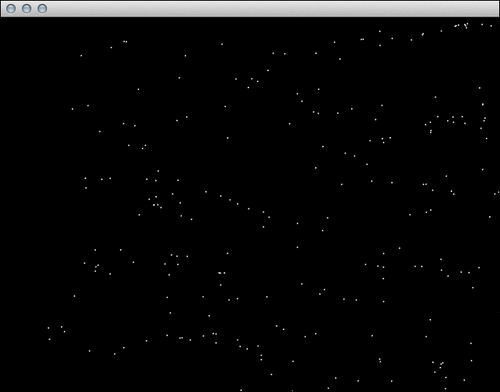In this recipe, we will explain how you can apply Brownian motion to your particles. Particles are going to behave like snowflakes or leaves flying in the wind.
In this recipe we are going to use the code base from the Creating a particle system in 2D recipe.
We will add movement to particles calculated from the Perlin noise and sine function. Perform the following steps to do so:
- Add the necessary headers.
#include "cinder/Perlin.h"
- Add properties to your application's main class.
float mFrequency; Perlin mPerlin;
- Set the default value inside the
setupmethod.mFrequency = 0.01f; mPerlin = Perlin();
- Change the number of the particles, their radius, and mass.
int numParticle = 300; float radius = 1.f; float mass = Rand::randFloat(1.f, 5.f);
- At the beginning of the
updatemethod, add the following code snippet:Vec2f oscilationVec; oscilationVec.x = sin(getElapsedSeconds()*0.6f)*0.2f; oscilationVec.y = sin(getElapsedSeconds()*0.2f)*0.1f; std::vector<Particle*>::iterator it; for(it = mParticleSystem.particles.begin(); it != mParticleSystem.particles.end(); ++it ) { Vec2f windForce = mPerlin.dfBm( (*it)->position * mFrequency ); (*it)->forces += windForce * 0.1f; (*it)->forces += oscilationVec; }
The main movement calculations and forces are applied in step 5. As you can see we are using the Perlin noise algorithm implemented as a part of Cinder. It provides a method to retrieve Brownian motion vectors for each particle. We also add oscilationVec that makes particles swing from left-to-right and backwards, adding more realistic behavior.

- Perlin noise original source: http://mrl.nyu.edu/~perlin/doc/oscar.html#noise
- Brownian motion: http://en.wikipedia.org/wiki/Brownian_motion
..................Content has been hidden....................
You can't read the all page of ebook, please click here login for view all page.
